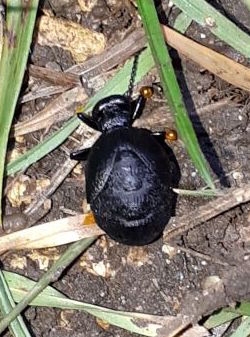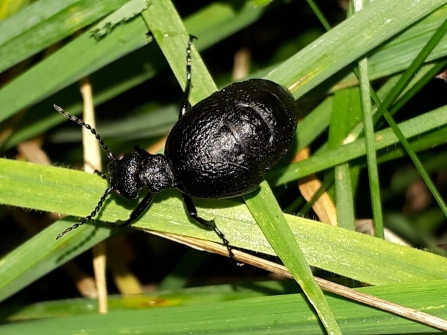Rugged Oil Beetles are fascinating creatures, both in terms of their individual character and their role in the wider ecosystem. They are a nest parasite of Solitary Mining Bees and subsequently restricted to the species-rich grasslands that these bees thrive in.
Rugged Oil Beetles in Gloucestershire
They are an indicator species for species-rich grassland habitats, and over the last few of years several organisations have established regular Rugged Oil Beetle surveys in order to record their numbers. I recently interviewed two of our GWT volunteers to find out more about their discoveries so far this season.
In the 1930’s, 40% of the Cotswolds was covered with unimproved species-rich calcareous grassland from the Jurassic periodStroud Valleys Reserves Manager, Gloucestershire Wildlife Trust
This type of habitat has since been lost in many parts of the countryside and is now very rare, with the figure from the Cotswolds reduced to less than 1.5%.
Gloucestershire Wildlife Trust is working hard to restore and connect areas of grassland on several sites. Rugged Oil Beetles are dependent on a healthy population of Solitary Mining Bees, so are only found in highly biodiverse ecosystems. They are highly sensitive to changes in land management so their presence therefore indicates successful habitat management and restoration.
Adult Rugged Oil Beetles feed on the leaves and petals of flowering plants and grasses. Each female holds up to 40,000 eggs and only mates once in her life, for an hour while feeding. She will dig two or three burrows, in an area of bare ground near a colony of Solitary Bees, and lay around 1000 eggs in each. The larvae (or ‘triungulins’) emerge in Spring and crawl to the tops of nearby flowers. Here they sit and wait for bees to land; larvae that are lucky enough to hook their feet onto a bee heading home will, on arriving at the nest, consume the bee eggs and nectar store. The beetle larva will remain in the bee burrow over winter and malt three times before emerging as an adult in September.

(c) Imogen Lois Robertson
For those who know where to look, adult beetles can be sighted between September and April when conditions are mild and overcast. Over the last few of years several organisations have established regular Rugged Oil Beetle surveys in order to record their numbers.
I’ve been leading surveys at Swifts Hill where we’re excited to have found the beetles in a new location. It is satisfying to know that our work will inform site management and help to preserve these delightful beetles for the future.Stroud Wildlife Survey Group
The Stroud Wildlife Survey Group works alongside Back from the Brink, a project run by a consortium of conservation and wildlife organisations such as Bug Life, Butterfly Conservation, Plant Life and the RSPB amongst others, sponsored primarily by the Heritage Lottery Fund, Peoples Postcode and Natural England. The project works to record the presence of indicator species found in specific habitats. It focuses on habitats which are in decline, for which the indicator species is usually rare, such as using Rugged Oil Beetle sightings as an indicator for species-rich grassland habitats.
I recently interviewed Nick and Mandy, two Gloucestershire Wildlife Trust volunteers who have been involved in Rugged Oil Beetle surveys on a number of our Nature Reserves. We talked about their experience searching for the beetles, discoveries they’ve made, and how data they’ve collected could contribute to future conservation management.
How were you first introduced to Rugged Oil Beetles and when did you start collecting data about them?
Nick and Mandy were first introduced to the world of Rugged Oil Beetles when they were invited to go on a course run by Back from the Brink in October 2017.
“A hundred years ago there were eight different types of oil beetle” says Nick, “and now we’re down to five. At one point we thought we were down to four, but then the Short-Necked Oil Beetle was rediscovered”.
Nick and Mandy started looking for Rugged Oil Beetles on several of our Nature Reserves in November 2017. On their first expedition they went to Bryworth Lane Nature Reserve, a site which had never been checked, and had one sighting. They initially didn’t find any on Daneway Banks Nature Reserve, but found two when they returned in late January, and found two at our Edward Richardson & Phyllis Amey (ERPA) Nature Reserve – finishing the season with a total of five sightings.
How do your findings from this year so far compare to those from last year?

(c) Amanda Cox
So far this year Nick and Mandy have sighted twenty-four Rugged Oil Beetles. With a fantastic thirteen records covering the top section of Daneway Banks, after having only surveyed the lower two thirds last year, evidence is pointing towards the species thriving across the entire reserve. This raises the question: are these beetles as rare as was previously thought, or simply underreported? As well as this, four sightings were recorded at Bryworth Lane and, as a very first sighting for the Nature Reserve, seven were found on Snow’s Farm!
“We don’t find them every night we look – the conditions have got to be right. They only come up when temperature is above 3’C. We started earlier this year because we know what we’re looking for, so we’ve had more of a chance to find them” says Mandy. Nick adds that “they gradually get predated over Winter, and have natural losses over Winter and early Spring”, which could also explain the higher numbers being found earlier in the season.
Can you describe how you would go about finding them, and in what conditions they are usually found?
“You have to go out at dusk” begins Mandy. “You’ve got to have a head torch on. Woolly hat, gloves, flask of tea…” adds Nick, “and you just have to go really slowly” describes Mandy.
“They do like paths, because they need clear areas to lay their eggs” continues Nick. “We were also finding them under clumps of grass – they seem to use longer grass for protection and warmth, and of course for food. We would sometimes find them on ant hills at Daneway… they seemed to like going up there.”
“We note down both the air temperature and the ground temperature wherever we find them, and Mandy sends the data to Back from the Brink and submits the sightings to iRecord. We usually find them singly, but occasionally in twos and threes, and once we found a whole line of them at Daneway which was a bit unusual.”
What is so special about them and how significant are they in terms of the wider ecosystem?

(c) Amanda Cox
“They’ve got quite a lot of character really,” says Nick. “They look funny, they’re big and bulbous, and their wing cases slightly overlap. They’re often thought to look like men in waistcoats!”
Mandy continues: “They secrete a toxic oil out of their leg joints – that’s why they’re called Oil Beetles. It’s a defence mechanism.”
“You don’t even have to touch them,” adds Nick. “A strong light seems to be enough to get them exuding bubbles of oil. They are nocturnal, so I suppose they might be sensitive to light. And anyway, they aren’t expecting anyone to find them!”
Rugged Oil Beetles are only found where there are Solitary Bees due to the prominent part they play in their lifecycle. Solitary Bees require wildflower rich sites with a succession of nectar sources throughout the Spring and early Summer – effectively a very biodiverse habitat. If a population of bees is thriving well enough to support a parasite, i.e. Rugged Oil Beetles, this provides a good indication that the site on which they are found is highly biodiverse.
How could the data you have collected affect future conservation management on the sites that they have been found?
“They do need flowers throughout the year, and they don’t want really long grass later in the Autumn – so there needs to be something grazing it,” says Nick. “The fact we don’t know anything about them means any information is valuable. They need a diverse environment, and that is what we are trying to achieve on the Nature Reserves anyway.”
Rather than needing to treat a site where the beetles have been found in a specific way, Nick and Mandy agree that if a Rugged Oil Beetle has been found in a particular place, it is an indication that the current land management is successful. The best action is therefore to continue maintaining habitats that show evidence of being favourable for the beetles.
“To be honest, there’s not a great deal known about them,” says Mandy, “and there’s a lot of contradicting information out there.”
“That is why this research is so important,” finishes Nick.
Epilogue
After overhearing mention of a Rugged Oil Beetle Song in previous conversation, I couldn’t resist asking for a performance to conclude the interview.
(In the interest of secrecy and trust, I can’t possibly allow the lyrics to be printed, but I can personally vouch for the fact that it is a masterpiece.)
“If we can’t find any we usually sing the song. And within five minutes – without fail, every time – one appears.”
“And we have a cup of tea.”
“Yes, it’s important to stop halfway through. Turn your lights off and have a cup of tea. Sit on a tussock or something. And you see deer eyes looking at you, which is quite worrying because you have no clue what it is – all you see are these eyes.”
Since the interview, Nick and Mandy have found six more beetles at ERPA, and one at Strawberry Banks – another first record!

(c) Amanda Cox
If you’d like to get involved with Rugged Oil Beetle surveying in Gloucestershire, please contact Back from the Brink (or the Stroud Wildlife Survey Group if you're local to Stroud).

